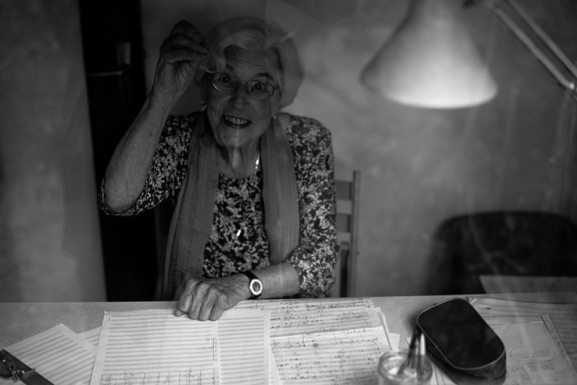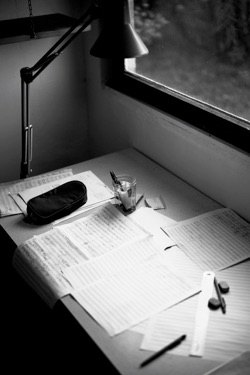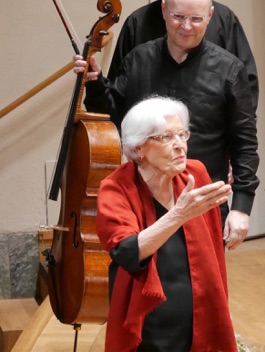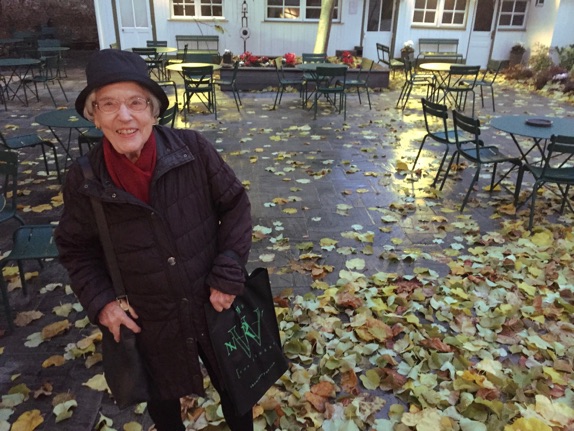Betsy Jolas

"Betsy has been a dear friend for many years. The first time I played her music was in 1998 at the Beauvais Cello Festival, the piece was Episode Cinquième for solo cello. Over the years we often met at concerts, Betsy has always been an avid listener, following all kinds of music, her fellow composers and performers she likes. In 2010 she wrote a piece for me called A Fancy fo Anssi as part of the Mystery Variations for my 50th birthday. Since then I hoped to persuade her to write something for me but wanted to find an idea that would be personal, significant and inspiring for her.
One evening we met at a performance of Poulenc’s La Voix Humaine. An idea flashed across my mind and I immediately put it to her. The idea came to me because there are two beautiful pieces for cello and string orchestra which are so short that they are difficult to program on their own, Toru Takemitsu’s Scene and Witold Lutoslawski’s Grave. Both of them are about 5 minutes long. I thought that if Betsy would write a third piece, they could be programmed either as a Triptych or separately, making the repertoire for cello and string orchestra much richer. How happy was I when she immediately said yes!
Almost like a reverse birthday gift, at her own 90th birthday party, Betsy showed me the first sketches of Side Roads. She finished it 10 months later, on July 17, 2017. While writing the piece, Betsy called me asking what should she do as the piece was growing longer and longer – more than the planned part of a Triptych! I naturally told her to keep going as long as she felt like it! The work finally became an almost 20 minutes long. It now has a double function; it is a major piece on its own and can also be played with the two other parts of the Triptych. Side Roads was commissioned jointly by the Swedish Chamber Orchestra and the Orchestre d’Auvergne. I premiered the Triptych with the Swedish Camber Orchestra and Gérard Korsten in October 2018. Betsy and I had an eventful trip to Örebro in Sweden, even ended up renting a car and driving, hesitating about taking the side roads or not.
Side Roads is a uniquely original piece which could not have been written without a knowledge and experience of all currents from the 16th to 21st century. Betsy Jolas can freely choose among all the roads that lead to great music without worrying about being on the main road. She moves comfortably around history and invention. She has developed a style that can fearlessly mix the most advanced new instrumental inventions with, say, references to Lassus or Bach. Betsy has her own way of being at once witty and profound, classical and avant-guard. She possesses the luxury of restraint, enjoys taking time to listen and rarely needs to raise her voice. Playing her music is like talking to someone who has seen it all. It teaches one to be a better person."
Anssi Karttunen


photo © Pascal Dusapin
photo © MvB


First pages of "Side Roads", 3.9. 2017
Betsy explaining the finished "Side Roads" 19.7.2018
Anssi Karttunen playing music by Betsy Jolas:
15.7.2016: Quatuor V, Domaine Forget, Quebec, Canada
22.2.2017: Quatre pieces en marge, Tirana, Albania (with Florent Boffard)
22.4.2017: Quatre pieces en marge, Reid Hall, Paris (with Nicolas Hodges)
5.10.2017: Episode cinquiéme, Nantes, France
7.10.2017: Episode cinquiéme, Philharmonie, Luxembourg
26.10.2017: Episode cinquiéme, UCDavis, California
4.11.2017: Episode cinquiéme, Centro Cultural Kirchner, Buenos Aires
18.10.2018: Side Roads, Örebro, Sweden
3.12.2018: Portrait of Betsy Jolas with Nicolas Hodges at the Reid Hall, Paris
30.10.2019: Portrait of Betsy Jolas with Nicolas Hodges in Clermont-Ferrand
31.10.2019: Side Roads with the Orchestre de Chambre d'Auvergne in Clermont-Ferrand

photo © Sven-Erik Flyckt

photo © MvB
photo © AvK
Betsy Jolas writing about her cello pieces:
SCION (1973) LISTEN
Scion was composed in 1973 to be played by all cellists taking the final examination of the Conservatory of Boulogne-Billancourt.
My first concern in writing this piece was to have to compose for an instrument which at the time I somewhat disliked, (I have since fortunately changed my mind)
More reasonably, I then felt the need to define in my own style the technical limits within which I would demonstrate some significant aspects of today's vocabulary. I named this work scion, a botanical term meaning a young shoot ready for grafting, as a metaphor designating the young student cellists who would soon perform it.
Episode #5 for cello (1983) LISTEN
Composed at the beginning of 1983, this work, following Berio’s example, is the fifth of a series of nine pieces named episode, featuring different solo instruments. It is also the first I devoted to a stringed instrument. Next would come episodes for viola, electric guitar, double bass and clarinet.
In Episode #5, rather than virtuosity, I have chosen to emphasize the exceptional lyrical qualities of the cello, while however, keeping them at all times under control through a rigorous yet flexible structure. Anecdotally, this structure is based on the notes of a congratulation message I sent Antoine Vitez, on his appointment at the head of the Théâtre de Chaillot.
Episode#5 was premiered in Paris in 1985 by Sonia- Wieder-Atherton.
Quatre pièces en marge - Four pieces on the fringe (1983). LISTEN
These little pieces were composed at odd moments on the corner of a kitchen table in August 1983, only a few months after my Episode cinquième. As such, they truly belong to the fringe of a rather momentous summer, hence this title.
The work finally turned out to be my response to a request from cellist Michel Tournus for his collection. As a member of the Trio à cordes Français, he had premiered my Quatuor II in 1966. Nearly twenty years later this suite, premiered by Philippe Muller, was already proof of my increasing interest in the cello. It has only kept growing ever since.
Mon Ami - My Friend (1974/2018) LISTEN
An arietta con variazioni, originally for female or child pianist to play-sing. This piece combines two childhood memories. The first is a little ditty I invented over 60 years ago for my baby daughter discovering echos. The tune has survived since in many arrangements and is now part of our family folklore.
My second memory goes back much further. It concerns the pre-war doings of another little girl, now become a great-grand-mother, who used to neglect practicing scales to sing inside the piano pedal down, and listen, fascinated, to the strings humming back her song.
The arietta Mon Ami was composed in 1974 in response to a request from pianist Michèle Boegner to complete her recording of pieces for children. It exists in several other versions, the newest one being for cello and piano.
Femme le soir (Woman in the evening) - 8 lieder for cello and piano (2018) LISTEN
- Lulling
- Songeries
- Shall we…
- Et toi, la bas…?
- Mots de sable
- Qui parle?
- Sing Maria!
- Bonjour
The great lied tradition entered my musical life many years ago thanks to my mother, a native of Louisville (KY), who had, among other gifts, a beautiful voice and was sent to Berlin to study singing in 1912.
I was myself still in my teens when I started accompanying her and thus discovered very early the rich lied repertoire which has since nurtured a good part of my thoughts on vocal music. Over the years I became interested in the way this repertoire had notably influenced instrumental music and began studying its favorite form: the cycle. I have thus written so far several such sets, featuring various solo instruments with orchestra or piano.
Following the tradition, my own cycles often have a general title and I have recently started to indicate sub-titles as well, for their power of suggestion in the absence of a sung text.
Composed in 2017-18, Femme le soir was premiered at the Reid Hall in Paris on the December 3rd by Anssi Karttunen and Nicolas Hodges to whom the piece is dedicated.
Betsy Jolas 2018
Betsy Jolas: Notes sur violoncelle
SCION (1973)
Cette pièce composée en 1973 pour le concours de fin d'année du CNR de Boulogne -Billancourt, m'imposait une double contrainte. Ecrire pour un instrument qu'alors je n'aimais guère, (j'ai heureusement depuis changé d'avis). Définir plus sérieusement dans mon propre style les limites techniques à l'intérieur desquelles j'illustrerai quelques aspects significatifs du vocabulaire d'aujourd'hui.
Enfin je décidais de nommer cette oeuvre Scion, terme qui désigne en botanique le jeune rameau qui sera greffé, comme métaphore de sa destination à de jeunes violoncellistes en cours d'étude.
Episode cinquième pour violoncelle (1983)
Composée au début de 1983, cette œuvre, à l’exemple des sequenza de Berio, est la cinquième d’une série de neuf pièces de même titre consacrées à divers instruments solistes. Elle est aussi chez moi la première destinée à un instrument à cordes. Lui ont succédé à ce jour des épisodes pour alto, guitare électrique, contrebasse et clarinette.
Plutôt qu’offrir ici une démonstration de la virtuosité du violoncelle, j’ai preferé exploiter ses exceptionnelles qualités lyriques, mais en quelque sorte tenues en respect grâce à une structure à la fois rigoureuse et sensible à ses élans naturels. Pour la petite histoire, celle-ci s’appuie sur le notes d’un d’un billet de félicitations adressé à Antoine Vitez pour sa nomination à la tête du Théâtre de Chaillot.
L’œuvre fut créée à Paris en 1985 par Sonia Wieder Atherton
Quatre pièces en marge (1983)
Composées à des moments perdus en août 1983, au coin d’une table de cuisine, quelques mois à peine après mon Episode cinquième, ces petites pièces s’inscrivent véritablement en marge d’un été mouvementé, d’où ce titre. L’oeuvre sera ma réponse à une demande pour sa collection du violoncelliste Michel Tournus. Membre du Trio à cordes Français, il avait créé mon Quatuor II en 1966. Près de vingt ans plus tard, créée par Philippe Muller, cette petite suite apparaitra comme un vivant témoignage de mon intérêt grandissant pour le violoncelle, dont on sait qu’il n’a cessé depuis de m’inspirer.
MON AMI (1974/2018)
Ariette variée, originellement à jouer-chanter pour pianiste femme ou enfant. Cette pièce est née de deux souvenirs d’enfance. Le premier est une chansonnette inventée il y a plus de 60 ans pour ma petite fille découvrant l’écho.
Reprise régulièrement depuis sous divers arrangements au gré des circonstances, cette chansonnette fait désormais partie de notre folklore familial.
Le second souvenir, bien plus lointain, concerne une autre petite fille, aujourd’hui arrière-grand-mère, qui s’amusait avant-guerre, au lieu de travailler ses gammes, à chanter à l’intérieur de piano, pédale déprimée, et à écouter les cordes lui renvoyer sa chanson…
L’ariette variée Mon Ami a été composée en 1974 à la demande de la pianiste Michèle Boegner pour compléter son enregistrement de pièces pour enfants. On l’entendra ce soir dans une nouvelle version pour violoncelle et piano.
Femme le soir - 8 lieder pour violoncelle et piano (2018)
- Lulling
- Songeries
- Shall we…
- Et toi, la bas…?
- Mots de sable
- Qui parle?
- Sing Maria!
- Bonjour
La grande tradition du lied est entrée dans ma vie musicale il y a bien des années grâce à ma mère. Née à Louisville (Kentucky) en 1893 et douée notamment d’une voix superbe, elle fut envoyée étudier le chant à Berlin en 1912. J’eu ainsi la joie, dès que j’en fut capable, de l’accompagner quotidiennement et de découvrir très tôt un répertoire magnifique, dont je vois aujourd’hui qu’il n’a cessé de nourrir ma réflexion sur la voix.
Commençant à composer, j’ai été très vite préoccupée par ce que je ressentais comme l’influence de ce répertoire sur la musique instrumentale, tout en m’interrogeant sur la validité formelle de sa forme de prédilection : le cycle. J’ai ainsi composé tout au long de ma carrière plusieurs cycles de lieder pour instruments, dont Femme le soir est le dernier exemple.
Ces cycles portent souvent un titre général, mais afin d’orienter la perception de l’auditeur en l’absence de texte, je fais désormais figurer aussi dans les programmes, selon la tradition, les sous-titres plus évocateurs de chaque lieder.
Composé en 2017-18, Femme le soir fut crée à Paris, Reid Hall le 3 décembre 2018 par Anssi Karttunen et Nicolas Hodges, ses dédicataires.
Betsy Jolas
At the premiere of "Side Roads"
photo © Pascal Dusapin
photo © MvB